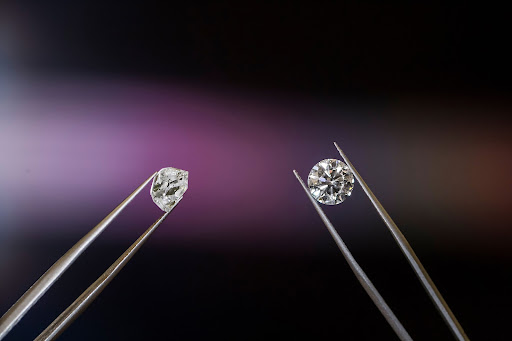Diamond Foundry has caught the hook of the media and the public because of their production of conflict-free diamonds. Some even question whether Diamond Foundry’s diamonds are the most sustainable ones in the market today.
The company even drew more attention when one of Hollywood’s biggest names, Leonardo DiCaprio, invested in the company because of realizations caused by the movie he once headlined—Blood Diamond. Whether it’s a questionable line of thought or not, it proves to be beneficial for the company and the diamond industry in general.
Table of Contents
Why Emphasize Conflict-Free?
As a company, one of its main selling points is marketing conflict-free diamonds. How significant is this anyway?
‘Blood Diamond’
The history of diamond mining is murkier than mud water. When the oldest known sources of diamonds, India and Brazil, were unable to keep up with the growing demand for the gem, discovery continued until they reached and discovered the reserves in South Africa.
South Africa had an abundant supply of diamonds, but then, the method of mining these precious stones became unethical and, ultimately, inhumane. Thus, the term ‘blood’ or ‘conflict’ diamonds came to be.
Such diamonds were mined in war-stricken areas in Africa and the miners were forced to work under inhumane conditions. Locals were forced to work under these conditions because this was only one of the ways to bring food to their table.
Aside from inhumane working conditions, most locals were also displaced from their homelands because the area was mined to look for more diamonds. In the same manner, wildlife was also disturbed and displaced as well. The unethical practices were so rampant and grave.
The situation got so bad that the United Nations (UN) had to step in to make systemic changes in the mining process of the diamond industry.
As such, technological innovations turned a new leaf for the diamond industry. It sprouted new-age methods to provide solutions for these issues. As a result, diamonds can now be grown and collected above ground, which is the method used by Diamond Foundry and several other synthetic or lab grown diamonds.
An Inspiration that Goes Both Ways

How exactly can a movie drive a celebrity to invest largely in a business about conflict-free diamonds? Well, let’s look at the premise of the movie.
Blood Diamond was a 2006 movie, headlined by Leonardo DiCaprio. Like any piece of fictional literature, the movie is a dramatic retelling of a war-torn country, in which the conflict was funded by diamond companies to further drive people away for them to mine more areas in the country. The movie was more like an exaggerated mirror of actual events that happened in Sierra Leone way back.
Although not explicitly stated, seeing vivid approximations of the violence and blatant disregard for human rights were too grave to ignore and let pass. DiCaprio’s support and advocacy for supporting conflict-free diamonds is also a step toward upholding human rights, humane working conditions, and better living conditions in war-stricken areas all for the production of diamonds.
How Conflict-Free Diamonds Are Produced
The spotlight is now on conflict-free diamonds. We’ve already discussed why they are considered as such. Now, let’s focus on how they are actually produced.
Diamond Foundry, in particular, describes its sustainable diamond as a crystallized greenhouse gas. Is this accurate?
In the simplest sense, it is actually accurate. Diamond is simply a hardened carbon, and one of the highest compositions of greenhouse gasses is carbon. As such, this also answers the recurring question of the authenticity of synthetic diamonds. Synthetic diamonds, contrary to common notions, are as real as the mined ones. They have the same composition of elements, the difference lies in how they are acquired. One is below-land, while the other is above-land.
There are two methods for creating synthetic diamonds.
- Chemical Vapor Deposition: This process requires a small piece of diamond and a vacuum chamber. What happens is that the diamond is sealed into the chamber and is then exposed to carbon-rich air. Over time, the diamond will literally grow as the ionized particles of the carbon-rich air will stick to the diamond.
- High-Pressure High Temperature: On the other hand, this process requires a piece of metal and electric pulses are essential to the diamond formation. Instead of carbon-rich air, pure carbon is pushed against the metal, releasing extreme heat and pressure through electric pulses.
Growing Preference for Lab Grown Diamonds
Many industries now turn to lab grown diamonds for several reasons. In fact, the availability of conflict-free diamonds jump-started the stagnant projects of some of these industries:
1.Jewelry Industry

Jewelry producers opt for lab grown diamonds to keep up with the public demand. Regardless of its simplicity or complexity, diamond jewelry pieces have always been a staple piece for those who have an affinity for jewelry. While for others, owning one is a life-long dream.
May it be a diamond proposal ring, a pair of earring studs, or even a complete set of diamond wedding jewelry, the demand for diamond jewelry has never died down and, most likely, will never do.
A steadier supply of diamonds is also a good thing for the industry. The prices can be a bit lower, inviting more people to buy different diamond pieces. At the end of the day, it’s a win-win situation for both the producer and consumer.
2.Manufacturing Industry
The manufacturing industry has a variety of industrial diamonds or nanodiamonds. Industrial diamonds are prized for their durability and ability to conduct heat, as opposed to the 4 C’s rubric for fashion or fine jewelry.
These diamonds were initially only used for grinding other extremely hard materials. But now, the emergence of synthetic diamonds sped up the industry’s technological developments as well. It led to the gems integration in semiconductors and lasers.
Diamonds that are great conductors are also used in optics. From basic mechanical processes like grinding, sanding, and cutting, industrial diamonds have come a long way in the manufacturing industry.
In Summary
Sometimes, forms of media open our eyes and turn out attention to real-life tragedies more effectively than daily news segments. In the case of DiCaprio, his role in ‘Blood Diamond’ exposed him to an exaggerated version of a very real and very tragic event that stemmed from diamond mining.
As such, the development of lab grown or synthetic diamonds is much more than just filling in the gap between the market’s demand and diminishing supply. It’s a step away from the murky and problematic lore surrounding diamond mining.
